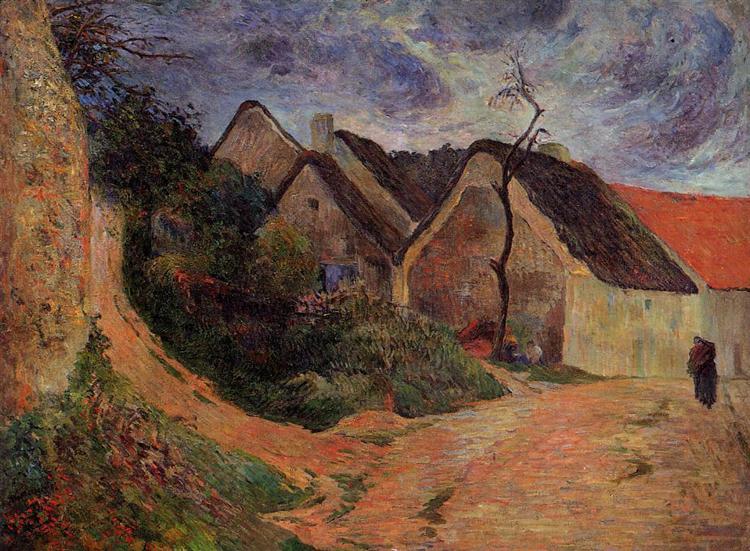Description
The painting "Calle del Pueblo - Osny - 1883" by Paul Gauguin represents a significant work in the development of his artistic style, marking a bridge between the impressionist and what would later be known as his synthesis of shapes and colors. In this painting, Gauguin portrays a rural landscape that emanates a captivating serenity, capturing a fragment of everyday life in a French village. The scene is located in Osny, a town that was recorded in the artist's memory for an intense exploration and experimentation period.
From the compositional point of view, the work presents a path that winds towards the distance, guiding the viewer's gaze through the pictorial space. On the left, the agrarian elements stand out with a variety of trees that provide a contrast to the visible architectural structure in the background, highlighting the relationship between nature and human construction. This use of space, where the horizontality of the road contrasts with the verticality of trees and buildings, offers a feeling of depth and a certain sense of movement.
Gauguin uses a color palette that feeds on terrible and green tones, generating an environment that reflects both the warmth of the sun and the freshness of the natural environment. The combination of yellow, green and brown not only brings realism to the scene, but also emphasizes the light that bathes the landscape and its effect on the elements of the environment. The color becomes a symbolic vehicle, at the same time that it recreates the feeling of peace and tranquility that can be expected from a rural life away from the bustle of the cities.
Although painting lacks very distinctive human figures, this does not strip it of a sense of life. The buildings and the road suggest the presence of inhabitants and daily activity, inviting the viewer to imagine people who could occupy that space. This Gauguin approach is characteristic of its style, where it often suppresses details of the human figure to focus attention on the environmental and emotional relationship with the environment.
The period in which Gauguin created this work was crucial, since he was immersed in impressionism while looking for his own voice in art. Although "Calle del Pueblo - Osny" may seem more conventional compared to his subsequent works, the features of his emerging style are evident. This includes a clear simplification of forms, a carefree approach to color and melancholic wisdom that would later intensify in his work in Polynesia.
In the context of the artistic movement of the late nineteenth century, this piece can be considered representative of the transition to the symbolism that Gauguin would embrace more fully in his subsequent works. While many of his contemporaries focused on naturalistic representation, Gauguin began to explore how formal and chromatic qualities could evoke emotions and highlight the essence of the subjects represented.
In summary, "Calle del Pueblo - Osny - 1883" is not only a portrait of a rural environment, but a testimony of Paul Gauguin's artistic journey, who would enter more exploratory and subjective territories in his career. This work, although often eclipsed by its most celebrated pieces, invites a deeper contemplation about the connection between art, nature and human experience, making it a valuable contribution to the understanding of the development of its style and vision Artistic
KUADROS ©, a famous paint on your wall.
Hand-made oil painting reproductions, with the quality of professional artists and the distinctive seal of KUADROS ©.
Reproduction service paintings With a guarantee of satisfaction. If you are not completely satisfied with the replica of your painting, we refund your money 100%.

